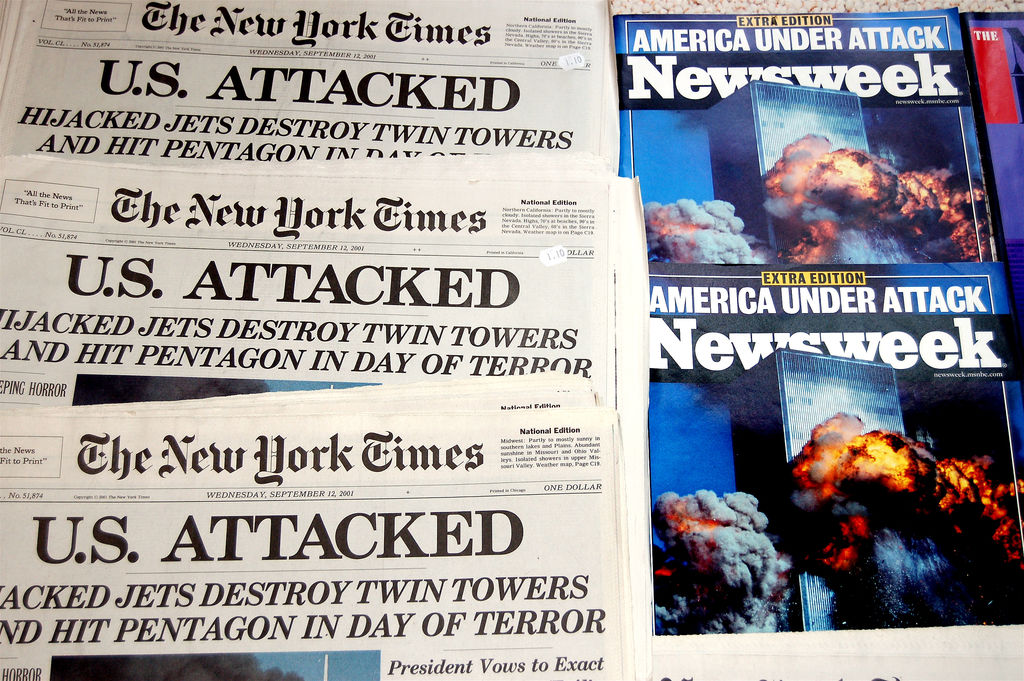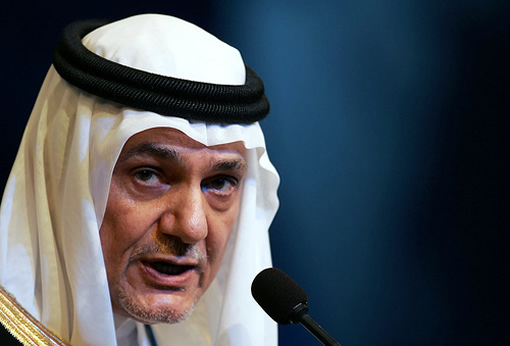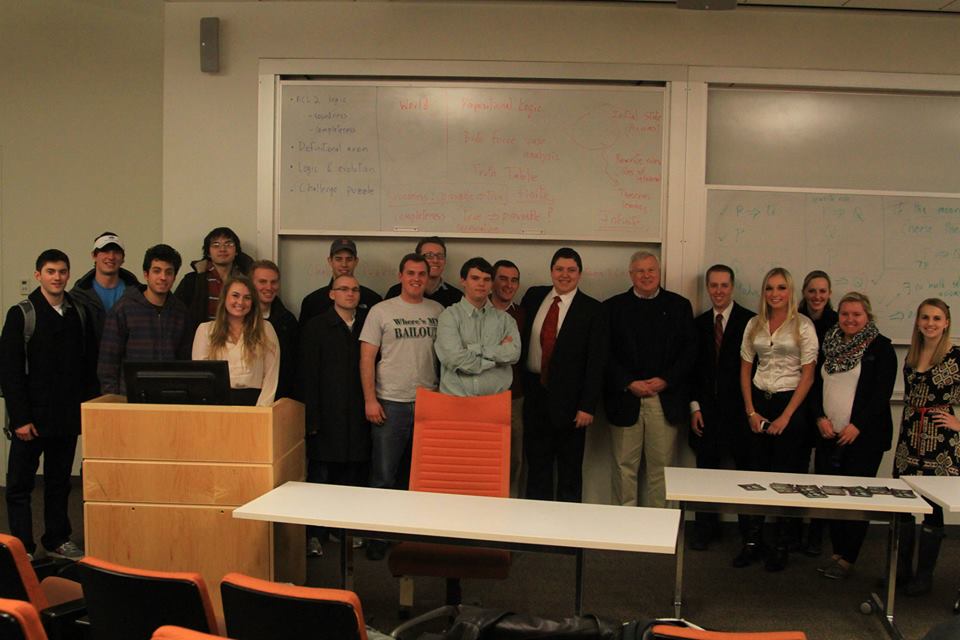“[Qaddafi’s death] confirms Obama’s moves regarding foreign policy; he may have a tough time with domestic, but most of his decisions internationally have been spot on—from killing Bin Laden to now the complete fall of Libya without [America] getting entangled.”[i] Media culture within the United States has become emboldened with the support of viewers and politicians, alike; technology aiding in the circulation of information, from traditional print to digital multimedia. Readers have gained a voice—the ability to respond to the news as it is generated, as one New York Time’s reader remarked on Kareem Fahim’s article, Violent End to an Era as Qaddafi Dies in Libya, above. Yet what role does the media play in galvanizing support from the American public to rally against a fictitious enemy in the ‘War on Terror’?
From the fabricated digital death mask of Osama Bin Laden to the conflicting accounts of the recent killing of Qaddafi, the media culture has the ability to fake just about anything. So where does truth diverge from fiction when our culture thrives upon the “networks of information and falsehood”[ii]? American perception has become akin to celebrating the death of the ‘enemy’ as a war trophy, utilizing the media’s tendencies as a façade to the genuine fears of the society—“Today our nation saw evil, the very worst of human nature.”[iii] The American ‘tendency’ to sensationalize within the media sector has significantly exploited the atrocities of September 11, 2001—paving the way to a fissure in policy making. As the dust cleared in downtown New York City, the media feasted upon the immense feelings of loss and sorrow, as much of the American society grieved for their loved ones. Ambition trumped trepidation as immediate feelings of fear and anger deeply inseminated public perception; “They see themselves as martyrs to a cause…we regard them as monsters”[iv] remarked one reader to the New York Times.
Such grandiose generalization caused an entire population, based tersely upon appearance, to unite against that of another, instituting a stigmatized version of ‘us’ verse ‘them’. The notion that a ‘group’ that had taken so many American lives, could be considered American was preposterous in the immediate aftermath of the attacks—yet the scapegoating of American Muslims lay primarily within the fault of ignorance and the subsequent exploitation of such.
Religious intolerance felt within American sentiment has suppressed the cultural complexity that exists within the Middle East, blurring the reality that Western culture is, in fact, not so different from that of ‘other’—the Arab, the Muslim, the Jewish, the Islamist, or the Middle Eastern. In the days following the attacks of 9/11, the approval ratings of then-President George W. Bush increased exponentially, jumping nearly 40%, to 90% approval in a period of ten days, the highest percentage rating during his presidency.[v] The former President was able to successfully mold public perception through the use of the media, labeling all Muslims, regardless of location, devotion, or religiosity, as “enemies of freedom and democracy.”[vi]
In his address to the American people on September 12th, President Bush made the fateful promise to bring the perpetrators to justice, pledging “we will make no distinction between the terrorists who committed these acts and those who harbored them.”[vii] With this pledge the American public created a stigmatized version of the villain for which all Muslims were persecuted. These politically induced misconceptions, driven by the media and warmly welcomed by popular sentiment, have come to dictate US foreign policy within the Middle East.
During a CNN interview of Muhammad Atta, conducted after the 2005 London Underground bombings, the father of “one of history’s most infamous mass murders” remarked that there remains a “whole cadre of Muslim holy warriors who, like his son, were willing to wage a fifty-year struggle against the West.”[viii] The authenticity of the perceived threat played perfectly into the waiting hands of the American media, exploiting the ease at which the public accepts, the media conveys and the state determines.
At the onset of the Iraq war in 2001, the public was sold a “war of American self-defense,” later promoted to “a war for the liberation of all Iraqis from the tyrannical Saddam Hussein.”[ix] The government and the media encouraged Americans to believe that “…Iraqis thought of themselves as Iraqis first and only then as Kurd, Sunni Arab, or Shiite Arab”. Such preconceived ‘confusion’ of motives allowed the US to fund a bloodbath, amounting to a religious war, a mask for a war plausibly based upon ulterior motives, oil. The American public had been left believing they were paying for their security, as the war in the Middle East grew increasingly expensive, far surpassing previous estimates of $200 billion by Lawrence Lindsey, a Bush financial advisor. Yet “…what did we buy for all of this?”—media exploitation at the hands of politicians has left the American citizenry standing as mere pawns in the face of a fabricated evil.

The stereotyping of such an evil has been reinforced by the continuous “news headlines often sensationalizing the potential for ‘homegrown terrorists’.”[x] Americans have come to view Islam, Muslims, mosques and to that effect, anything contrary to the understood and familiar, as “associated with anti-American attitude or behavior.”[xi] We, as a society, are willing to sacrifice our children for a few days of fighting in Iraq “against enemies that don’t [truly] exist”, as Joseph Stiglitz phrased it, based purely upon the mass anti-Muslim mentality that the media is cultivating.
After the 9/11 attacks on the World Trade Center in New York, there was a significant spike in news articles identifying association with terrorism or Islamic extremism, two such themes that had scarcely been a blip on the national agenda prior to that infamous day. Yet, the staunch anti-Muslim beliefs of a core group of conservative political activists, such as Pamela Geller, have been exaggerated within the mechanisms of the media, spreading their heresy into the homes of the American public. The Park51 Mosque, the proposed building of a mosque on the boundaries of Ground Zero, has served as an epicenter of division within American society, fueled by the colossal media coverage it attracted.
“…Building a shrine to the very ideology that inspired the terrorist attacks is an insult to the victims of 9/11” claims Pamela Geller on a national television broadcast by Fox News. Yet, the 2011 Muslim American Public Opinion Survey, polling over 1,400 Muslims living within the United States[xii], shows that mosques are working against the media generated perceptions of the general public, acting as “institutions that facilitate integration into US society as opposed to having an isolating effect.”[xiii] With such a wide breath of survey statistics readily available to the public, why is it that negative preemption is able to dominate the proactive voice of moderate Muslims against extremism, supporting the cry to “stop the Islamism of America”[xiv]?
Conflict—especially that perceived as between Western powers and Middle East, tyrannical rule and the spread of democracy—has become a contextual choice based upon a complex historical backdrop of a region commonly demonized by the US. Such contextualization of the Middle East—whether Iraq, Afghanistan, Tunisia, Egypt, or any other nation inhabiting the region—has brought about a necessity for individualized understanding of the cultures and society that occupy the land. Yet the image that the US media conveys to the people is that of commonality, a step from individualized contexts to a cohesive threat that projects all people as one.
Understanding is the key to forward mobility, an act “crucial for putting aside the West’s Islam Anxiety in favor of practical policymaking”.[xv] The American public’s deeply rooted negative impressions of Muslims, both home and abroad, have made political outreach within the Obama administration largely invisible. Ten years after the attacks, Muslim Americans continue to “confront suspicions and, in some cases, outright hatred.”[xvi] Yet, even after his speech at Cairo University in which Obama “asked the Muslim world for a new beginning”[xvii], Americans still consider the “image of a corpse as a data point”[xviii], an authentic symbol of American victory over the ‘enemy’.
As Juan Cole accurately acknowledges in his book, Engaging the Muslim World, “by abandoning the politics of distrust and fear, the new administration in Washington has the opportunity to repair America’s relations with the Muslim world…”[xix] Yet, acquiring the leverage to successfully alter American sentiment, such feelings that have become deeply rooted over the past decade, seems an implausible task. After all, the media acts merely as a tool of the ‘big wigs’ perched comfortably atop the power pyramid, exploiting the immense power the media sector wields over the American people to foster their own interest.
[i] Fahim, K. (2011, October 20). Violent end to an era as qaddafi dies in libya. The New York Times, Retrieved from http://www.nytimes.com/2011/10/21/world/africa/qaddafi-is-killed-as-libyan-forces-take-surt.html?_r=2
[ii] ibid.
[iii] Bush, G. W. (2001, September 12). A day of terror; bush’s remarks to the nation on the terrorist attacks. The New York Times, Retrieved from http://www.nytimes.com/2001/09/12/us/a-day-of-terror-bush-s-remarks-to-the-nation-on-the-terrorist-attacks.html?scp=5&sq=war on terror&st=nyt.
[iv] Hamilton, C. V. (2001, September 12). Dispatches from a day of terror and shock; a need for restraint. The New York Times, Retrieved from http://www.nytimes.com/2001/09/12/opinion/l-dispatches-from-a-day-of-terror-and-shock-a-need-for-restraint-145564.html?scp=7&sq=war on terror&st=nyt
[v] (2011). Presidential approval ratings — george w. bush. Gallup, Retrieved from http://www.gallup.com/poll/116500/presidential-approval-ratings-george-bush.aspx
[vi] Dana, K. (2011). Mosques as american institutions: mosque attendance, religiosity and integration into the political system among american muslims. relgions, 504.
[vii] Bush, G. W. (2001, September 12). A day of terror; bush’s remarks to the nation on the terrorist attacks. The New York Times, Retrieved from http://www.nytimes.com/2001/09/12/us/a-day-of-terror-bush-s-remarks-to-the-nation-on-the-terrorist-attacks.html?scp=5&sq=war on terror&st=nyt.
[viii] Cole, J. (2009). Engaging the muslim world. (p. 60). New York, NY: Palgrave Macmillan.
[ix] Burgard, S. (2010). Faith, politics & press in our perilous times. (p. 36). Kendall Hunt Publishing.
[x] Dana, K. (2011). Mosques as american institutions: mosque attendance, religiosity and integration into the political system among american muslims. relgions, 517.
[xi] ibid.
[xii] Dana, K. (2011). Mosques as american institutions: mosque attendance, religiosity and integration into the political system among american muslims. relgions, 504.
[xiii] ibid. 510
[xiv] Man behind the mosque [Television series episode]. (2011). In Frontline. New York, NY: PBS. Retrieved from http://www.pbs.org/wgbh/pages/frontline/man-behind-mosque/
[xv] Cole, J. (2009). Engaging the muslim world. (p. 44). New York, NY: Palgrave Macmillan.
[xvi] Wilson, S. (2011, September 05). Obama’s outreach toward muslims is limited at home. The Washington Post, Retrieved from http://www.washingtonpost.com/politics/obamas-outreach-toward-muslims-is-limited-at-home/2011/08/22/gIQAySL74J_story.html
[xvii] ibid.
[xviii] Fahim, K. (2011, October 20). Violent end to an era as qaddafi dies in libya. The New York Times, Retrieved from http://www.nytimes.com/2011/10/21/world/africa/qaddafi-is-killed-as-libyan-forces-take-surt.html?_r=2
[xix] Cole, J. (2009). Engaging the muslim world. (p. 240). New York, NY: Palgrave Macmillan.


